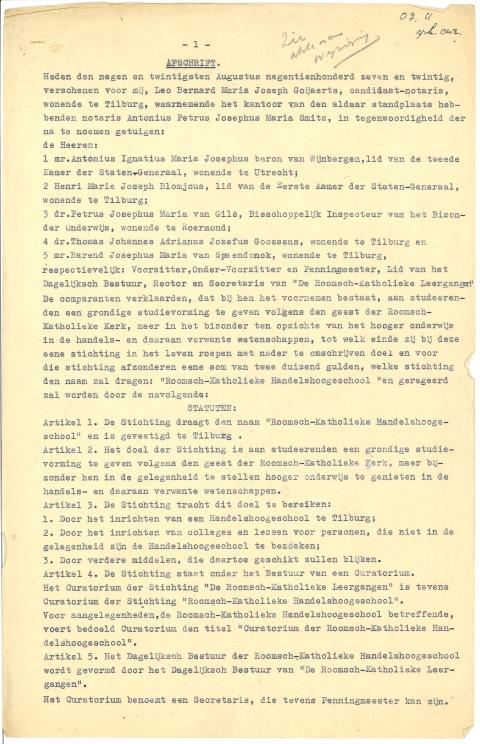The deed of foundation and the dies natalis
On "the twenty-ninth of August nineteen hundred twenty-seven, five gentlemen appeared before Tilburg's “junior civil-law notary ” Goijaerts to form the first board of the Roomsch Katholieke Leergangen. The deed was passed a few days before the start of the first academic year and the purpose of the foundation was "to give those who study a thorough education according to the spirit of the Roman Catholic Church, more specifically, to give them the opportunity to receive higher education in the commercial and related sciences."

The deed of foundation from 1927 (pictured above)
The articles of association state that a governing board (curatorium) is responsible for the day-to-day management, which also forms the board of the Roomsch Katholieke Leergangen. These colleges form one of the legal predecessors of the present Fontys Universities of Applied Sciences, located in Tilburg on a campus in the south of the city.
The date on which the deed of foundation passed is not the date on which the university celebrates the dies natalis (Latin for "day of birth"). The difficulty of August 29 is that a week later a second important festivity takes place: the opening of the academic year. Hence, an alternative was needed, and that became March 7, the date on which "The Dutch Episcopate announced to the faithful entrusted to them, Blessed in the Lord, that a Roman Catholic College of Commerce would be established in Tilburg."
On reflection, this was not a fortunate date either, and that was because of Lent. It was inappropriate to celebrate then. After a discussion of more than ten years with the curatorium, which initially stood firm, the curatorium agreed to a change. By letter, on May 10, 1940, the day the Second World War broke out, it was announced that the dies natalis would henceforth be celebrated on November 21, on the day of the "Presentation of Mary"—the day Mary was predestined by her parents in the temple for her task.
The program of the dies remained the same for a long time: in the morning, a Holy Mass in the church on the Heuvel, in the afternoon the dies speech by the Rector in the Auditorium, in the evening the full professors' dinner, followed by a festive evening with students. The Holy Mass fell into oblivion in the 1970s, while the festive evening became more and more alluring. At that time, for practical reasons, it was decided to abandon the exact date and opt for a fixed moment: the third Thursday of November.
That seems a wise decision since there are two other dates besides March 7 and November 21 that could qualify as Dies Natalis. The first, of course, is August 29; the second is October 8. That is the date on which the first academic session took place in 1927, in establishment the New Royal Harmony on Stationsstraat. This date is also listed on the Beadle's staff.
More about history and academic heritage
The Tilburg University academic heritage is a very diverse set of archives, visual materials, collections, devices, recorded stories, et cetera that relate to the history of the university.